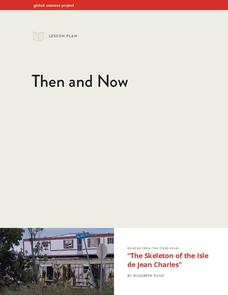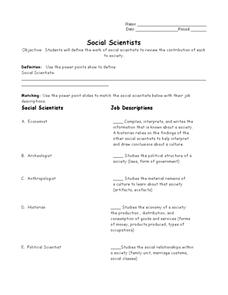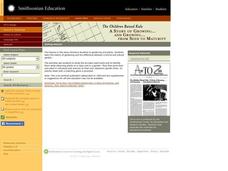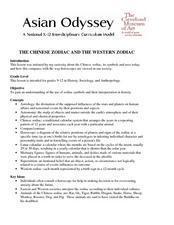Cultural Anthropology Teacher Resources
Find Cultural Anthropology lesson plans and worksheets
Showing 226 resources
University of Chicago
Using Artifacts for Clues About Identity
Learn about the ancient Near East through a close examination of ancient artifacts. Lead your class into analysis by first observing an artifact as a class. Pupils can then work in pairs to analyze the other artifacts and compile a list...
Global Oneness Project
Then and Now
The devastating changes happening to the Native American inhabitants of an island off the coast of Louisiana are the topic of an informational lesson. After scholars break into groups to explore particular topics, they come back together...
Curated OER
Alaskan Eskimo Collection
Students analyze mystery photographs to determine key characteristics about the Alaskan environment and Eskimo culture. In this Eskimo lesson, students read an Eskimo folktale and write their own in response. Lastly students complete a...
Curated OER
Dance Around the World
Students gather information about traditional dances. In this folk dance lesson plan, students work in small groups to research a type of folk dance, then present information and perform the dance for the class.
Curated OER
African Americans during the Great Depression
Middle schoolers interpret patterns of behavior reflecting values and attitudes that contribute or pose obstacles to cross-cultural exploration. They explain and apply ideas, theories and modes of inquiry drawn from anthropology and...
Curated OER
Social Scientists
In this social scientist worksheet, learners respond to 10 matching and short answer questions about the work of economists, archaeologists, anthropologists, historians, and political scientists.
Curated OER
Albert Schweitzer: Darkness And Light
Learners view a documentary which examines the life and work of Albert Schweitzer. Specifically, it explores the controversy surrounding Schweitzer. Darkness and Light would be useful for classes on World History, African History and...
Curated OER
Baga Drum
Learners examine a Baga Drum in order to explore the history of the Baga people of West Africa. In this art history lesson, students recognize figures used in Baga Drum design that represent aspects of Baga culture. They also design and...
American Museum of Natural History
What Do You Know About Archaeology?
A 10-question interactive permits young anthropologists to study the field of archaeology and the tools archaeologists use to dig into history.
Curated OER
I Heard the Owl Call My Name
Eleventh graders write a two to three page paper addressing one of the following topics: Analyze the values and beliefs of the two conflicting cultures. Explain which values seem to dominate within the conflict and why. They brainstorm...
Curated OER
The Arts of Africa, Asia and the Middle East: An Exploration of Art, Music and Film
Pupils examine the arts of the Middle East, Asia and Africa. After viewing films, they discuss the views of the various characters and identify the differences in the cultures presented. They also use the internet to evaluate various...
Curated OER
Understanding Artifacts
Students will develop a greater awareness of the things surrounding them and will be able to build a bridge between their own material culture and that of an imaginary figure from the past. This instructional activity focuses on the...
Curated OER
social Studies: Yesterday, Today, and Tomorow
Sixth graders take an Internet trip back in time to explore ancient cultures. Working in teams, they assume the roles of theologian, cartographer, economist, political analyst, and anthropologist. The same groups then create time...
Curated OER
The Chinese Zodiac And The Western Zodiac
High schoolers create individual horoscopes that contrast and compare Western and
Chinese views of their futures using poster boards and magic markers. In-class discussion is used to evaluate the use of the Zodiac in different cultures.
Curated OER
Vocab-u-lous! Build a Fabulous Vocab: Words Beginning with TR
In this vocabulary activity, students select the best word to complete the sentence. They are challenged by the difficult words that contain a tr-blend.
Curated OER
Ethical Dilemmas
Students analyze anthropological case studies. In this specific Ethical Dilemmas lesson, students make ethical judgments based on the case study analysis. Students work cooperatively in small groups to reach their conclusions.
Curated OER
Ancient Cultures
Students develop archeological skills in order to explain how scientists determine what ancient cultures were like. They develop an appreciation of the work that is involved in finding out about our past.
American Museum of Natural History
Mint Your Own Coin
Provide young archaeologists with an opportunity to craft their own artifacts. The step-by-step directions in an engaging resource show them how to mint their own coin, complete with image, date, and motto.
American Museum of Natural History
Dress Up a Horse
Walk, trot, gallop! Young equestrians have an opportunity to learn all about horses with an engaging resource that lets them select tack to dress up a horse, create flip books that illustrate the various gates, have questions answered by...
American Museum of Natural History
Sounds of the Silk Road
Young explorers may not be able to travel the Silk Road but they can listen to music that was played on instruments of the time and create their own songs with the help of an interesting interactive resource.
American Museum of Natural History
Silk Road Fables
Talk about rabbit holes! With just this one resource, learners can travel the Silk Road listening to fables, meet a scientist who studies poisons (and whose favorite book is Alice in Wonderland), and listen to a video interview of an...
Curated OER
Ka'ianaa'ahu'ulu: A Leader of Hawai'i
Students evaluate leadership traits in 18th century Hawai'i and modern times. In this leadership skills lesson plan, students identify leadership traits and read the story of Ka’iana. Students monitor the leadership activities of a...
Be Smart
Why Do We Cook?
Are you hungry right now? If you are, it might be because your brain is so large. The video describes the shift from larger jaw to larger brain and the relationship of larger brains to cooking. Crushing, preserving, and drying also made...
Smithsonian Institution
Watching Crystals Grow
Amazing science can sometimes happen right before your eyes! The class gets cozy as they watch crystals grow. They use Epsom salts, rocks, and food coloring to create crystals. They'll observe the entire process, documenting every step...

























